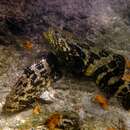Biology
provided by Arkive
The goliath grouper may be solitary or occur in groups of up to 50 or more individuals. Home range appears limited and the fish produces a booming sound when threatened by divers or large sharks. Variations of these vocalizations also undoubtedly have intraspecific communicative properties (4). During the breeding season from July through September, goliath groupers gather together at breeding sites in groups of 100 individuals or more, for periodic spawning. The fertilised eggs are scattered in the water column of the ocean and develop into kite-shaped larvae with long dorsal fin spines and pelvic fin spines (3) (4). About a month or more after hatching, the larvae mature into juveniles of just 2.5 cm long and settle preferentially into mangrove habitat (3) (4). These fish are very long-lived with a slow growth rate and late sexual maturation. Males begin breeding at four to six years and females mature at six to seven years. However, if goliath grouper are like most other groupers, they may undergo a sex-change part way through life, starting out as a female and becoming males at some later time, but this has never been observed in this species (3).
Goliath groupers feed on crustaceans, such as spiny lobsters, shrimps and crabs as well as fish including stingrays and parrotfish, in addition to octopuses and young sea turtles. Despite having teeth, the fish engulfs its prey and swallows it whole. Before the goliath grouper reaches full-size it is susceptible to the attack of barracuda, king mackerel and moray eels, as well as sandbar sharks and hammerhead sharks (3). Once fully grown, humans and large sharks are the goliath grouper's only predator (3) (4).
Conservation
provided by Arkive
During the 1980s there was an observed reduction in numbers within spawning aggregations of the goliath grouper dropping from over 100 individuals per location to less than 10 individuals, and numbers were suspected to have been reduced by 80%. This prompted legislative protection preventing fishing of this species. In the ten years following the implementation of the legislation, numbers of individuals in each spawning aggregation rose to 20 – 40 individuals (3).
Description
provided by Arkive
The goliath grouper is the largest member of the sea bass family. Its body is large and stocky, measuring half as wide as it is long. The head is broad with small eyes and the pectoral fins and tail fins are rounded. The first and soft dorsal fins are joined together along the back of the fish, and the bases of the first dorsal fin and anal fins are covered with scales and thick skin. Goliath groupers are dull green, grey, or dark yellow to brown, with small dark spots on the head, body and fins. Smaller individuals of less than one metre long are more decorative, with three or four faint vertical bars on their sides. Juveniles are tawny-coloured with dark banding and blotching. This predatory fish has several rows of small teeth in the jaw and small pharyngeal teeth (3) (4).
Habitat
provided by Arkive
This marine fish inhabits shallow, inshore waters with mud, rock or coral bottoms and is infrequently found below depths of 46 m. Juveniles inhabit mangroves and associated structures for the first four to six years of their lives, then egress to offshore reefs at about 1 m in length (4). Adults prefer structured habitat, such as rocky ledges, caves, and ship wrecks (1) (3) (4) (5).
Range
provided by Arkive
The goliath grouper is found in the eastern Atlantic Ocean from Senegal to Congo, but is particularly rare around the Canary Islands, and in the western Atlantic Ocean from Florida to Brazil including the Gulf of Mexico and the Caribbean Sea. They are also found in the eastern Pacific Ocean from the Gulf of California to Peru (2) (3).
Status
provided by Arkive
The goliath grouper is classified as Critically Endangered (CR A1d +2d) on the IUCN Red List 2003.
Threats
provided by Arkive
This species is particularly prone to over-fishing because of its large size, slow growth rate, low reproductive rate and group spawning activity. The fish has excellent quality flesh and has been at risk of spear-fishing for recreation and sport (3).

